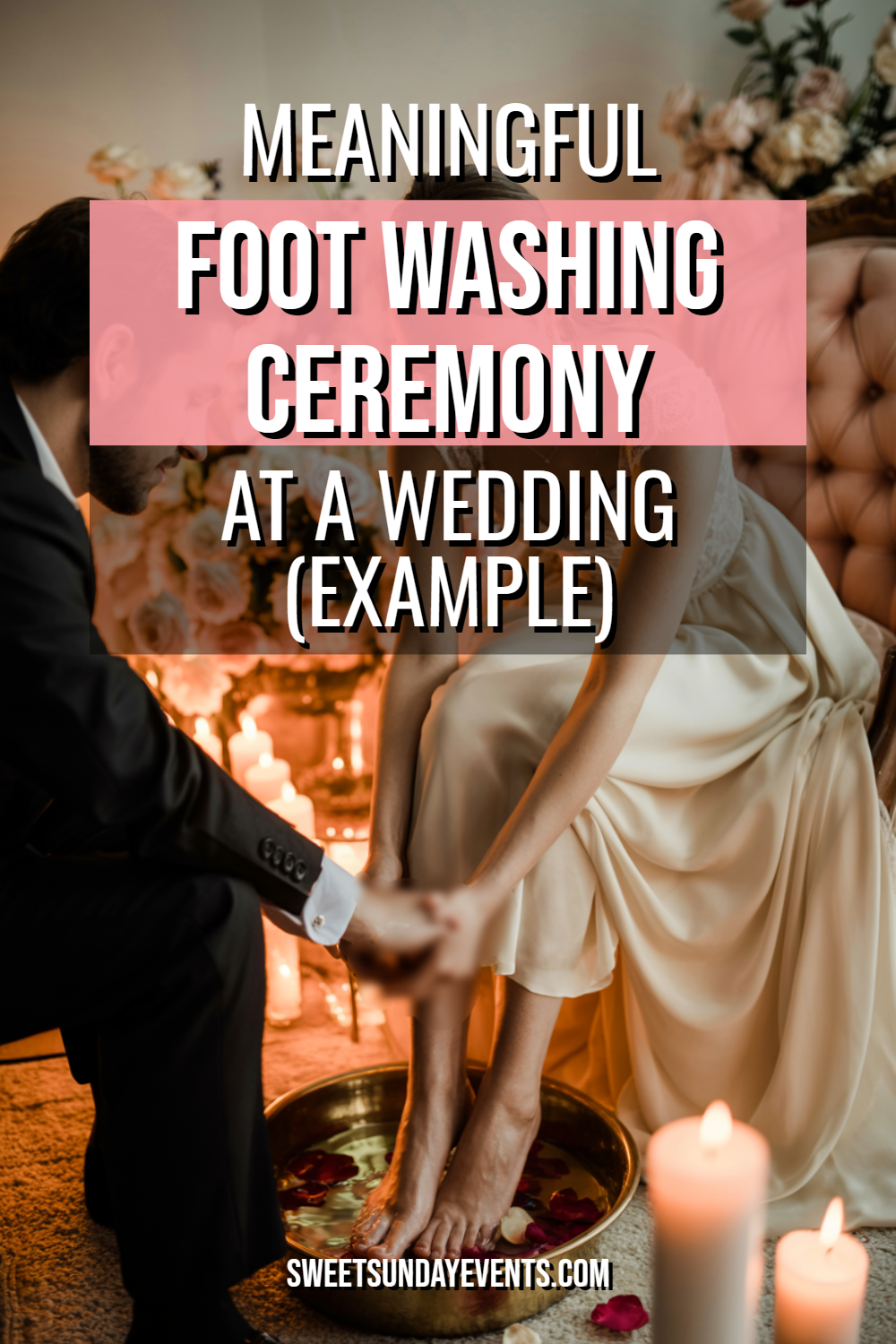Foot washing ceremonies at weddings often catch guests off guard – one moment you’re watching a traditional exchange of vows, the next you’re witnessing something deeply intimate and profoundly meaningful. This ancient ritual has found its way into modern weddings as couples seek ways to demonstrate humility, service, and unconditional love in their union.
Planning Your Foot Washing Ceremony
Logistics matter more than you might expect with this ceremony. You’ll need specific supplies, appropriate timing, and clear communication with your officiant and wedding party about what’s happening.
The key is making sure everyone involved understands the significance while keeping the practical elements smooth. Nothing ruins a sacred moment quite like scrambling for towels or realizing the water basin is too small.
Essential Supplies and Setup
Your supply list is surprisingly simple but absolutely crucial. You’ll need a large, beautiful basin or bowl that fits comfortably between you and your partner. Choose something that photographs well since this moment will definitely be captured.
Provide plenty of clean towels – more than you think you’ll need. Have a pitcher of warm water ready, and consider adding essential oils or flower petals for a special touch. The water temperature should be tested beforehand; cold water kills the moment’s intimacy.
Create a small table or designated area near your ceremony space for these items. Some couples use a vintage washstand or decorated side table that matches their wedding aesthetic. Position it where guests can see clearly but where you’ll have enough privacy for the intimate moment.
Timing Within Your Ceremony
Most couples place the foot washing ceremony after their vows but before the ring exchange. This timing allows the ritual to flow naturally from your spoken commitments into this physical demonstration of service.
Alternative timing includes immediately after the ring exchange, treating it as a sealing of your vows. Some couples prefer it at the very beginning of their ceremony, symbolically cleansing themselves before making their promises.
Discuss timing thoroughly with your officiant. They’ll need to guide the transition smoothly and may want to offer brief explanations to guests who might be unfamiliar with the ritual.
Step-by-Step Ceremony Guide
The actual ceremony requires careful choreography to maintain its sacred nature while ensuring practical smoothness. Both partners should practice the movements beforehand to avoid awkward fumbling during the actual moment.
Your officiant will typically explain the ceremony’s significance to guests before you begin. This context helps everyone understand they’re witnessing something deeply meaningful rather than just an unusual wedding tradition.
The Washing Process
Begin by removing your shoes and socks together. This simple act already demonstrates vulnerability and equality. One partner sits in the designated chair while the other kneels beside the basin.
Pour the water slowly and deliberately – this isn’t a rushed process. Gently wash your partner’s feet with your hands, taking time to make eye contact and connect emotionally. The washing should be thorough but reverent, not clinical.
Dry their feet completely with the towel, again taking your time. Some couples exchange quiet words during this process, though many find the silence more powerful. Switch positions and repeat the entire process for the second partner.
Words and Prayers During the Ritual
Many couples choose to remain silent during the washing, letting the actions speak entirely. Others incorporate brief prayers, scripture readings, or personal promises spoken quietly between partners.
If you’re including spoken elements, keep them short and meaningful. Long speeches disrupt the intimate flow of the physical ritual. Simple phrases like “I promise to serve you with love” or “I wash away anything that stands between us” work beautifully.
Your officiant might offer a closing prayer or blessing after both partners have participated. This helps transition back to the broader ceremony while honoring what just occurred.
Guest Preparation and Communication
Your guests will likely be unfamiliar with this ceremony, so preparation becomes crucial for everyone’s comfort. Include a brief explanation in your wedding programs or have your officiant provide context before beginning.
Consider your guest list when planning this ceremony. Some family members might feel uncomfortable with the intimate nature of foot washing, while others will be deeply moved by its significance.
Program Explanations and Context
Your wedding program should include a paragraph explaining the ceremony’s meaning and biblical foundation. Keep the language accessible to guests from various religious backgrounds or those who aren’t particularly spiritual.
Sample program text: “During our foot washing ceremony, we demonstrate our commitment to serve one another with humility and love, following the example of Jesus washing his disciples’ feet. This ritual symbolizes our promise to care for each other in both joyful and challenging times.”
Consider including the relevant scripture reference for guests who might want to look it up later. This small detail shows respect for the tradition while educating your loved ones about your choice.
Managing Different Comfort Levels
Some guests might find the ceremony too intimate or religiously specific for their comfort. Address this by focusing on the universal themes of service and humility rather than specific theological interpretations.
Brief conversations with key family members beforehand can prevent surprised reactions during your ceremony. You’re not asking for approval, just providing a heads-up about what they’ll witness.
Common Variations and Personal Touches
Every couple brings their own style to this ancient ritual. Some add music, others incorporate family heirlooms, and many find creative ways to honor their cultural backgrounds alongside the traditional ceremony.
The goal is making the ritual authentically yours while respecting its sacred origins. Personal touches should enhance rather than overshadow the ceremony’s core meaning.
Cultural Adaptations
Interfaith couples often blend the Christian foot washing tradition with elements from their other cultural backgrounds. Jewish couples might incorporate prayers from their tradition, while those from other faiths find ways to honor both spiritual paths.
Some couples use water from meaningful locations – their baptism site, where they got engaged, or a place significant to their families. These additions create deeper personal connections to the ritual.
Creative Elements and Enhancements
Musical accompaniment can enhance the ceremony’s emotional impact. Choose instrumental pieces or meaningful songs that won’t distract from the ritual itself. Live acoustic guitar or string quartet work particularly well.
Flower petals in the water add visual beauty and pleasant fragrance. Rose petals are traditional, but choose flowers that match your wedding colors or hold special meaning for your relationship.
Some couples incorporate essential oils known for their symbolic properties – lavender for peace, eucalyptus for healing, or frankincense for spiritual connection. A few drops in the water create a sensory experience that enhances the ceremony’s impact.
Practical Considerations and Logistics
Beyond the spiritual significance, practical planning ensures your ceremony runs smoothly. Consider factors like your wedding dress, venue limitations, and photography needs when incorporating this ritual.
Weather concerns for outdoor weddings, accessibility issues for elderly or disabled family members, and time constraints all impact how you structure the ceremony.
Venue and Space Requirements
Indoor venues typically accommodate foot washing ceremonies more easily than outdoor locations. You’ll need level ground, adequate space for movement, and protection from wind that might disrupt the water or your ceremony flow.
Outdoor ceremonies require backup plans for weather. Strong winds can make the ritual difficult, while rain obviously creates complications. Have a covered area available or be prepared to modify the ceremony if needed.
Consider your venue’s cleanup policies. Some locations have restrictions about water usage or require specific cleanup procedures. Discuss these details with your venue coordinator well in advance.
Photography and Videography Coordination
This ceremony creates incredibly powerful photos and video footage, but your photographer needs advance notice to position properly. The intimate nature requires careful angle consideration to capture the moment’s beauty while maintaining appropriate privacy.
Discuss lighting needs with your photographer. The ceremony often involves kneeling and bending, which can create challenging shadows. Additional lighting might be necessary for quality photos.
Video coverage should focus on facial expressions and the gentle movements of the washing process. Many couples treasure this footage as some of their most meaningful wedding memories.
Making the Moment Meaningful
The ceremony’s power lies not in perfect execution but in genuine intention and emotional connection. Focus on each other rather than worrying about how you look or whether you’re doing everything “right.”
This ritual offers a rare opportunity for complete vulnerability and intimacy in front of your loved ones. Embrace the moment’s sacred nature and let it set the tone for your entire marriage.
Emotional Preparation
Expect to feel emotional during this ceremony. Many couples are surprised by how moving the experience becomes, even when they’ve planned it carefully. The combination of vulnerability, service, and love often creates overwhelming feelings.
Discuss your expectations and any nervousness with your partner beforehand. Some people feel self-conscious about their feet or about kneeling in front of others. Address these concerns openly and remind each other that this moment is about love, not perfection.
Creating Lasting Impact
The foot washing ceremony often becomes couples’ most treasured wedding memory. The intimate connection and symbolic power create lasting impact that extends far beyond the wedding day.
Many couples establish anniversary traditions based on their foot washing ceremony, recreating elements of the ritual each year. This continuation reinforces the original promises and keeps the ceremony’s meaning alive in their marriage.
Final Thoughts on Sacred Service
Including a foot washing ceremony in your wedding requires courage and conviction. You’re choosing vulnerability over perfection, service over status, and meaning over convention.
This ancient ritual offers modern couples a profound way to begin their marriage with humility and intentional love. When executed with genuine hearts and careful planning, it becomes a cornerstone memory that shapes how you serve each other throughout your life together.
The ceremony’s beauty lies in its simplicity and depth. Two people, some water, and a commitment to serve – sometimes the most powerful wedding moments require the least elaborate planning but the most open hearts.


